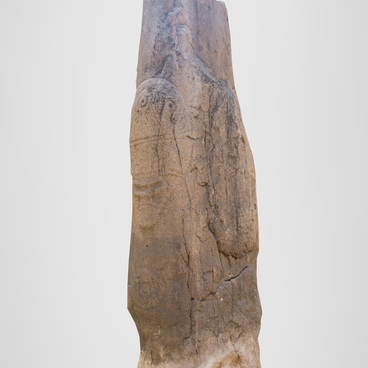The slab with the image of a bull was found by a museum employee, archaeologist Eduard Kirginekov, during excavations in 1995 near the Mokhov ulus of the Ust-Abakan region. An ulus was a tribal community with a certain territory.
In this expedition, the researchers studied the mound of the late 3rd — early 2nd millennium BC. It belonged to the Okunev culture — the South Siberian archaeological culture of the Bronze Age cattle herders. It dates back to the 2nd millennium BC. It is widespread on the territory of Khakassia and in the southern part of the Krasnoyarsk Territory, named after the Okunev ulus area.
In their funeral rites, the Okunevites engraved images to slabs, which were then used in the construction of burial mounds. It is believed that some of these slabs were in sanctuaries and then ended up in burials. And some of them were made specifically for burials.
In the center of the mound was a grave — a rectangular box made of sandstone slabs. On one of the ends of the tomb, a slab with the figure of a large bull was found. It was installed in such a way that the head of the animal was turned upside down. The image of a powerful bull occupies the entire surface of the slab. The drawing is silhouetted, made using the technique of pecking, small and very dense. Legs, tip of tail and massive nape are complemented by carved lines. Sexual characteristics are clearly marked; small horns are visible in the form of two short lines. The front legs are shown in motion, and the lines shown below seem to entangle the animal.
The image of a bull in ancient times was widely known and widespread in many cultures. This is largely due to the fact that cattle breeding appeared and began to develop in the Eurasian steppes. In addition, the bull was a character in ancient myths and was considered one of the main elements of the world structure. According to some researchers, the drawing on the slab denotes a sacrificial animal, and others believe it is an image of a “isykh”. This was the name of the animals, which, after a special ceremony, were considered sacred and dedicated to spirits.
Thanks to the drawings on the slabs, scientists managed to find out at what time many objects of the ancient fine art of the Khakass-Minusinsk depression were created: stone statues and stelas with masks.
In this expedition, the researchers studied the mound of the late 3rd — early 2nd millennium BC. It belonged to the Okunev culture — the South Siberian archaeological culture of the Bronze Age cattle herders. It dates back to the 2nd millennium BC. It is widespread on the territory of Khakassia and in the southern part of the Krasnoyarsk Territory, named after the Okunev ulus area.
In their funeral rites, the Okunevites engraved images to slabs, which were then used in the construction of burial mounds. It is believed that some of these slabs were in sanctuaries and then ended up in burials. And some of them were made specifically for burials.
In the center of the mound was a grave — a rectangular box made of sandstone slabs. On one of the ends of the tomb, a slab with the figure of a large bull was found. It was installed in such a way that the head of the animal was turned upside down. The image of a powerful bull occupies the entire surface of the slab. The drawing is silhouetted, made using the technique of pecking, small and very dense. Legs, tip of tail and massive nape are complemented by carved lines. Sexual characteristics are clearly marked; small horns are visible in the form of two short lines. The front legs are shown in motion, and the lines shown below seem to entangle the animal.
The image of a bull in ancient times was widely known and widespread in many cultures. This is largely due to the fact that cattle breeding appeared and began to develop in the Eurasian steppes. In addition, the bull was a character in ancient myths and was considered one of the main elements of the world structure. According to some researchers, the drawing on the slab denotes a sacrificial animal, and others believe it is an image of a “isykh”. This was the name of the animals, which, after a special ceremony, were considered sacred and dedicated to spirits.
Thanks to the drawings on the slabs, scientists managed to find out at what time many objects of the ancient fine art of the Khakass-Minusinsk depression were created: stone statues and stelas with masks.



